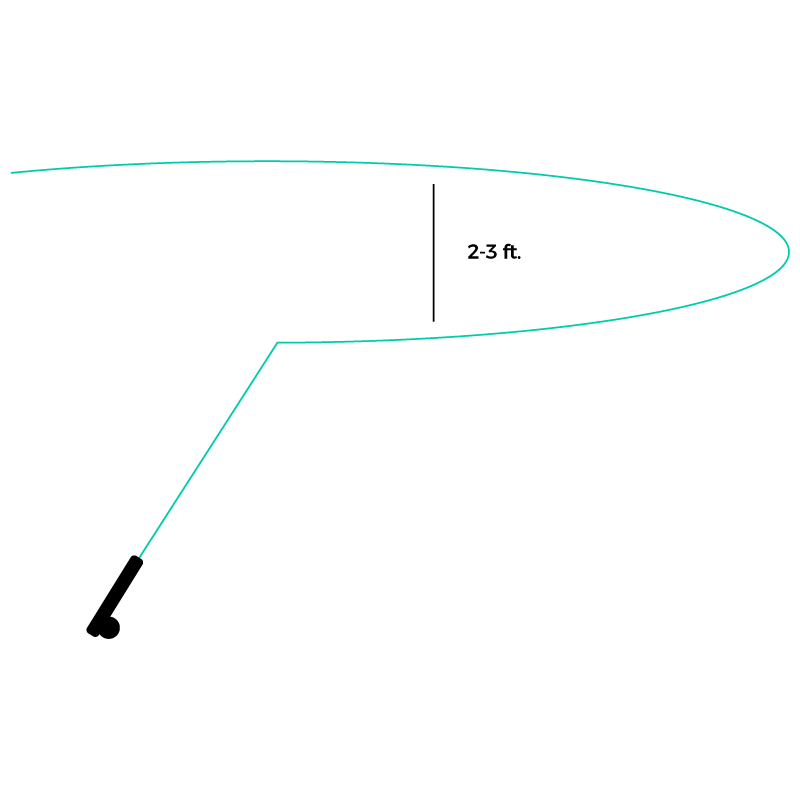How-to Cast for Fly Fishing
Fly fishing casting is different from traditional casting. Rather than relying on the weight of the lure when the angler casts their rod, they rely on the weight of the fly line to toss out a virtually weightless artificial fly. The goal is to trick the fish by imitating the fish’s natural food source: a fallen insect that skirts the surface of the water. One of the most common ways to fly fish is wading, but this sport offers enough flexibility that it can also be done from land, a canoe, a kayak, or even a boat.
Safety Precautions
Fly fishing is a relatively safe sport, but as with any activity in or around water, there are inherent dangers and certain safety precautions you should take to keep yourself and fellow anglers out of harm’s way while fly casting. If you use some common sense and a little caution around the water you’ll be well-equipped for your fly fishing adventure, but always have this key safety tip in mind: Keep an eye on your fly line. Your line is like a whip and can easily get caught on trees or other anglers.
Understanding Your Fly Casting Rod
We mentioned before that fly fishing is different from traditional fishing because of the way the angler uses the weight of the line rather than the weight of the lure or bait. This requires a unique casting method (arguably one of the most difficult to learn) and specialized equipment. Your casting technique is going to incorporate a series of strokes that result in bends and ultimately, a U-shaped loop, so fly casting rods are more flexible than their traditional counterparts to allow for this movement.
Introduction to the Fly Line
Typically, you want to match your fly casting equipment, so you’ll choose a fly casting rod and fly line that complement each other. There are quite a number of components to consider when choosing the right equipment, but in this introduction let’s focus solely on the basics of your fly line. The fly line is an integral piece of your fly fishing gear. Using the fly line’s weight is how you will carry and present the light-weight fly to the fish, and this is the reason why fly fishing casting is so distinct as compared to traditional casting.
How To Cast a Fly Fishing Rod
Now that you have a basic understanding of your fly fishing equipment, it’s time to learn how to cast with a basic overhead cast. To grasp your rod, put your thumb on the top of the grip. Your grip should be loose and comfortable until you force stop the rod at the end of your strokes.
Loading and Stroking the Rod
When you first start learning fly fishing casting, loading and stroking will be one of the most difficult concepts to grasp; but try thinking of transferring energy through the line, like hammering a nail. The ultimate goal of your cast is to create smooth and straight U-shaped loop with the fly line, so your fly casting rod is much more flexible than traditional rods to allow it to bend and unbend with the weight of the fly line to create that loop.
Back Stroke
The first movement in your cast is whipping back your fly rod, otherwise referred to as the back stroke, or backcast. Keep your elbow close to your side with a stiff wrist throughout the full stroke. When you pull back, watch your line to see how it moves. It should move in the same way as a hammer, quickly before abruptly stopping upon impact with the nail. Whip your fly rod back, accelerating quickly to load (bend) your rod, then stop to let it unload. What you should see is the momentum of your stroke travelling down the line as it moves backwards in a straight line.
Forward Stroke
After a brief pause at the end of your back stroke, whip the fly rod forward in a straight line. Your forward stroke should be done quickly to transfer the energy into the motion and keep the fly line from wandering. When done correctly, you will stop abruptly once more while the tip of the fly rod is pointing up and be able to feel the rod unload as the line carries the fly to the water, releasing the U-shaped loop.
Remember Practice Makes a Perfect Cast
Fly fishing casting is one of the most difficult casts to master, so don’t feel disheartened if your first casts don’t work out. Try practicing on land before heading out to the water so you can get a feel for your fly rod and line. If you can, record yourself as you try casting the fly line to see where you might be making mistakes. Then, once you’ve mastered this basic overhead cast, you can adapt your cast for different fish and locations with a roll cast, curve cast or even a double haul.
The Loop: How to Know You’re Casting Correctly
- The loop is smooth, straight and unloads in a parallel motion.
- The loop is narrow (~2-3 feet between the top and bottom).













Comments
Please log into your account to post comments